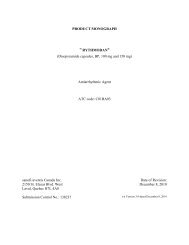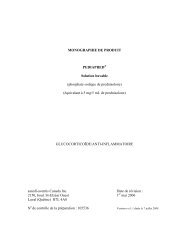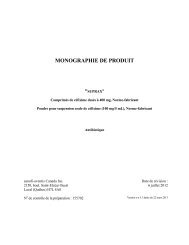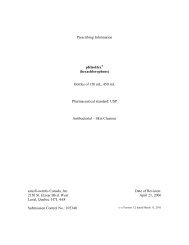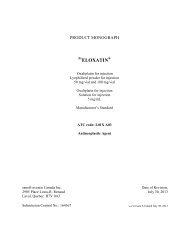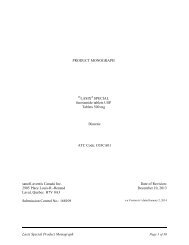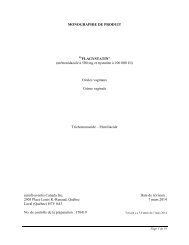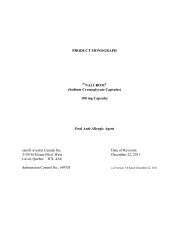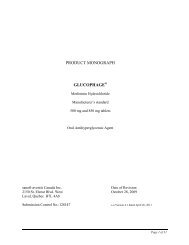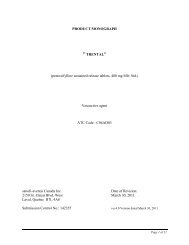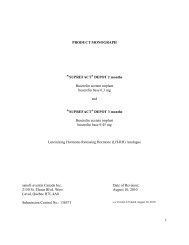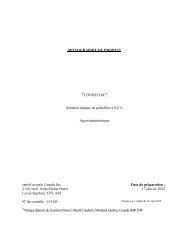Suprax (cefixime) - Sanofi Canada
Suprax (cefixime) - Sanofi Canada
Suprax (cefixime) - Sanofi Canada
Create successful ePaper yourself
Turn your PDF publications into a flip-book with our unique Google optimized e-Paper software.
sanofi-aventis <strong>Canada</strong> Inc.<br />
2150 St. Elzear Blvd. West<br />
Laval, Quebec H7L 4A8<br />
Submission Control No. : 155702<br />
PRODUCT MONOGRAPH<br />
Pr SUPRAX ®<br />
Cefixime tablets, Mfr. Std., 400 mg<br />
Cefixime for oral suspension, Mfr. Std., 100 mg/5 mL<br />
Antibiotic<br />
Date of Revision:<br />
July 6, 2012<br />
s-a Version 5.1 dated March 22, 2013
PRODUCT MONOGRAPH<br />
Pr SUPRAX ®<br />
Cefixime tablets, Mfr. Std., 400 mg<br />
Cefixime for oral suspension, Mfr. Std., 100 mg/5 mL<br />
THERAPEUTIC CLASSIFICATION<br />
Antibiotic<br />
ACTION AND CLINICAL PHARMACOLOGY<br />
SUPRAX (<strong>cefixime</strong>) exerts its bactericidal effect by attaching to penicillin-binding proteins<br />
(PBP) and inhibiting peptidoglycan synthesis, thus causing damage to the bacterial cell wall.<br />
Following oral dosing, SUPRAX attains peak serum levels in approximately 4 hours. The<br />
half-life is about 3 to 4 hours and is not dose dependent. Cefixime is excreted by renal and<br />
biliary mechanisms. About 50% of the absorbed dose is excreted unchanged in the urine within<br />
24 hours. There is no evidence of metabolism of <strong>cefixime</strong> in vivo.<br />
INDICATIONS AND USAGE<br />
SUPRAX (<strong>cefixime</strong>) is indicated in the treatment of the following infections caused by<br />
susceptible strains of the designated microorganisms:<br />
Upper Respiratory Tract:<br />
Pharyngitis and tonsillitis caused by S. pyogenes.<br />
Middle Ear:<br />
Otitis media caused by S. pneumoniae, H. influenzae (beta-lactamase positive and negative<br />
strains), M. catarrhalis (former B. catarrhalis) (beta-lactamase positive and negative strains) and<br />
S. pyogenes.<br />
Paranasal sinuses:<br />
Sinusitis caused by S. pneumoniae, H. influenzae (beta-lactamase positive and negative strains),<br />
and M. catarrhalis (former B. catarrhalis) (beta-lactamase positive and negative strains).<br />
Page 2 of 28
Lower Respiratory Tract:<br />
Acute bronchitis caused by S. pneumoniae, M. catarrhalis (former B. catarrhalis)<br />
(beta-lactamase positive and negative strains) and H. influenzae (beta-lactamase positive and<br />
negative strains).<br />
Urinary Tract:<br />
Acute uncomplicated cystitis and urethritis caused by E. coli, P. mirabilis, and Klebsiella<br />
species.<br />
Uncomplicated Gonorrhea:<br />
Uncomplicated gonorrhea (cervical/urethral and rectal) caused by Neisseria gonorrhoeae,<br />
including penicillinase (beta-lactamase-positive) and nonpenicillinase (beta-lactamase-negative)<br />
producing strains.<br />
Appropriate cultures should be taken for susceptibility testing before initiating treatment with<br />
SUPRAX. If warranted, therapy may be instituted before susceptibility results are known;<br />
however, once these are obtained, therapy may need to be adjusted.<br />
CONTRAINDICATIONS<br />
SUPRAX (<strong>cefixime</strong>) is contraindicated in patients with known allergies to the cephalosporin or<br />
penicillin antibiotics or to any ingredients in the formulation or component of the container.<br />
Hypersensitivity:<br />
WARNINGS<br />
IN PENICILLIN-SENSITIVE PATIENTS, SUPRAX (CEFIXIME) SHOULD BE<br />
ADMINISTERED CAUTIOUSLY. PATIENTS MAY BE SENSITIVE TO PENICILLINS<br />
AND NOT TO CEPHALOSPORINS SUCH AS SUPRAX OR BE SENSITIVE TO BOTH.<br />
MEDICAL LITERATURE INDICATES THAT PATIENTS SENSITIVE TO<br />
CEPHALOSPORINS ARE VERY LIKELY TO BE PENICILLIN SENSITIVE.<br />
Antibiotics, including SUPRAX, should be administered cautiously to any patient who has<br />
demonstrated some form of allergy, particularly to drugs.<br />
Severe Cutaneous Adverse Reactions:<br />
Severe cutaneous adverse reactions such as toxic epidermal necrolysis, Stevens-Johnson syndrome<br />
and drug rash with eosinophilia and systemic symptoms (DRESS) have been reported in some<br />
patients on SUPRAX. When severe cutaneous adverse reactions occur, SUPRAX should be<br />
discontinued and appropriate therapy and/or measures should be taken.<br />
Page 3 of 28
Clostridium Difficile-Associated Disease:<br />
Clostridium difficile-associated disease (CDAD) has been reported with use of many<br />
antibacterial agents, including SUPRAX. CDAD may range in severity from mild diarrhea to<br />
fatal colitis. It is important to consider this diagnosis in patients who present with diarrhea, or<br />
symptoms of colitis, pseudomembranous colitis, toxic megacolon, or perforation of colon<br />
subsequent to the administration of any antibacterial agent. CDAD has been reported to occur<br />
over 2 months after the administration of antibacterial agents.<br />
Treatment with antibacterial agents may alter the normal flora of the colon and may permit<br />
overgrowth of Clostridium difficile. C. difficile produces toxins A and B, which contribute to the<br />
development of CDAD. CDAD may cause significant morbidity and mortality. CDAD can be<br />
refractory to antimicrobial therapy.<br />
If the diagnosis of CDAD is suspected or confirmed, appropriate therapeutic measures should be<br />
initiated. Mild cases of CDAD usually respond to discontinuation of antibacterial agents not<br />
directed against Clostridium difficile. In moderate to severe cases, consideration should be given<br />
to management with fluids and electrolytes, protein supplementation, and treatment with an<br />
antibacterial agent clinically effective against Clostridium difficile. Surgical evaluation should be<br />
instituted as clinically indicated, as surgical intervention may be required in certain severe cases.<br />
Hemolytic Anemia:<br />
SUPRAX SHOULD NOT BE USED IN PATIENTS WITH A HISTORY OF<br />
CEPHALOSPORIN-ASSOCIATED HEMOLYTIC ANEMIA SINCE THE<br />
RECURRENCE OF HEMOLYSIS IS MUCH MORE SEVERE.<br />
An immune mediated hemolytic anemia has been observed in patients receiving cephalosporin<br />
class antibacterials, including SUPRAX. Severe cases of hemolytic anemia, including fatalities,<br />
have been reported with cephalosporins in both adults and children. If a patient develops anemia<br />
anytime during, or within 2-3 weeks subsequent to the administration of SUPRAX, the diagnosis<br />
of a cephalosporin-associated anemia should be considered and the drug discontinued until the<br />
etiology is determined.<br />
Patients may benefit from periodic monitoring for signs and symptoms of hemolytic anemia,<br />
including measurement of hematological parameters or drug-induced antibody testing, where<br />
appropriate (see ADVERSE REACTIONS).<br />
Acute Renal Failure:<br />
As with other cephalosporins, SUPRAX may cause acute renal failure including tubulointerstitial<br />
nephritis. When acute renal failure occurs, SUPRAX should be discontinued and appropriate<br />
therapy and/or measures should be taken.<br />
Page 4 of 28
General:<br />
PRECAUTIONS<br />
If an allergic reaction to SUPRAX (<strong>cefixime</strong>) occurs, the drug should be discontinued, and, if<br />
necessary, the patient should be treated with appropriate agents, e.g., pressor amines,<br />
antihistamines, or corticosteroids.<br />
The possibility of the emergence of resistant organisms, which might result in overgrowth,<br />
should be kept in mind, particularly during prolonged treatment. In such use, careful observation<br />
of the patient is essential. If superinfection occurs during therapy, appropriate measures should<br />
be taken.<br />
Broad-spectrum antibiotics such as SUPRAX should be prescribed with caution in individuals<br />
with a history of gastrointestinal disease.<br />
Once daily dosing only must be used for urinary tract infections, since twice daily dosing was<br />
shown to be not as effective in clinical studies.<br />
Do not use SUPRAX to treat Staphylococcus aureus as this strain of staphylococcus is resistant<br />
to <strong>cefixime</strong>.<br />
Renal Impairment:<br />
SUPRAX should be used with particular care in the presence of severely impaired renal function.<br />
Dose modification is recommended for patients with moderate or severe renal impairment (i.e.,<br />
creatinine clearance of < 40 mL/min) (see PHARMACOLOGY and DOSAGE AND<br />
ADMINISTRATION).<br />
Bioavailability Differences Between Tablet and Suspension:<br />
The area under the time versus concentration curve is greater by approximately 26.4% and the<br />
Cmax is greater by approximately 20.7% with the oral suspension when compared to the tablet<br />
after doses of 400 mg. This increased absorption should be taken into consideration if the oral<br />
suspension is to be substituted for the tablet. Because of the lack of bioequivalence, tablets<br />
should not be substituted for oral suspension particularly in the treatment of otitis media where<br />
clinical trial experience with the suspension only is available (see DOSAGE AND<br />
ADMINISTRATION).<br />
Drug/Drug Interactions:<br />
SUPRAX should be administered with caution to patients receiving coumarin-type<br />
anticoagulants such as warfarin potassium. Since SUPRAX may enhance effects of the<br />
anticoagulants, prolonged prothrombin time with or without bleeding may occur (see ADVERSE<br />
REACTIONS and PHARMACOLOGY).<br />
Page 5 of 28
Drug/Laboratory Interactions:<br />
A false-positive reaction for ketones in the urine may occur with tests using nitroprusside but not<br />
with those using nitroferricyanide.<br />
The administration of beta-lactams may result in a false-positive reaction for glucose in the urine<br />
using Clinitest * , Benedict's solution, or Fehling's solution. It is recommended that glucose tests<br />
based on enzymatic glucose oxidase reactions (such as Clinistix * ) be used.<br />
A false-positive direct Coombs test has been reported during treatment with cephalosporin<br />
antibiotics; therefore, it should be recognized that a positive Coombs test may be due to the drug.<br />
Usage in Pregnancy:<br />
The safety of SUPRAX in the treatment of infection in pregnant women has not been<br />
established.<br />
Reproduction studies have been performed in mice and rats at doses up to 400 times the human<br />
dose and have revealed no evidence of impaired fertility or harm to the fetus due to <strong>cefixime</strong>.<br />
Because animal reproduction studies are not always predictive of human response, this drug<br />
should be used during pregnancy only if the likely benefits of using SUPRAX outweigh the<br />
potential risk to the fetus and/or the mother.<br />
Labour and Delivery:<br />
SUPRAX has not been studied for use during labour and delivery.<br />
Nursing Mothers:<br />
It is not known whether SUPRAX is excreted in human milk. Because many drugs are excreted<br />
in human milk, caution should be exercised when SUPRAX is administered to a nursing woman.<br />
Usage in Children:<br />
Safety and effectiveness of SUPRAX in children less than six months old have not been<br />
established.<br />
Clinical Trials:<br />
ADVERSE REACTIONS<br />
Five percent (5%) of patients in the clinical trials discontinued therapy because of drug-related<br />
adverse reactions. Thirty-six percent of the pediatric patient population experienced at least one<br />
adverse reaction (mild 25%, moderate 9%, severe 2%). Forty-seven percent of the adult patients<br />
* Reg. Trademark of Bayer Healthcare LLC subsidiary of Bayer Corporation.<br />
Page 6 of 28
experienced at least one adverse reaction (mild 24%, moderate 19%, severe 4%). The most<br />
commonly seen adverse reactions in the clinical trials of the tablet formulation were<br />
gastrointestinal events, which were reported in 37% of all adult patients treated (mild 21%,<br />
moderate 13%, severe 3%). The predominant adverse events seen in adults in clinical trials with<br />
SUPRAX (<strong>cefixime</strong>) were diarrhea 15%, (mild 7.2%, moderate 6.2%, severe 1.5%), headache<br />
11%, stool changes 12%, nausea 9%, abdominal pain 5%, dyspepsia 3%, flatulence (3%),<br />
dizziness (3%) and vomiting (2%). The rates of the most prevalent adverse reactions were<br />
similar in the once a day and twice a day dosing regimens with the exception of headache, which<br />
appears slightly more frequently in adults, dosed once a day (12.9%) versus twice a day (8%).<br />
Other than for generally mild rashes or emesis, which were each observed in 5% of children<br />
treated, the incidence of adverse reactions in pediatric patients receiving the suspension was<br />
generally comparable to the incidence seen in adult patients receiving tablets.<br />
These symptoms usually responded to symptomatic therapy or ceased when SUPRAX was<br />
discontinued.<br />
Several patients developed severe diarrhea and/or documented pseudomembranous colitis, and a<br />
few required hospitalization.<br />
When SUPRAX was used as single 400 mg dose therapy in clinical trials in the treatment of<br />
uncomplicated gonorrhoea, adverse reactions which were considered to be related to SUPRAX<br />
therapy, were reported for 5.9% (21/358) of patients. Clinically mild gastrointestinal side effects<br />
occurred in 3.7% of all patients, moderate events occurred in 0.9% of all patients and no adverse<br />
reactions were reported as severe. Individual event rates included diarrhea 1% and loose or<br />
frequent stools 1%. Incidence rates for all other adverse reactions reported for adults in these<br />
trials were less than 1%.<br />
Clinical Trial and Post-Market Adverse Drug Reactions:<br />
The following adverse reactions have been observed during clinical trial studies and/or during<br />
marketed use.<br />
Blood and lymphatic system disorders:<br />
Thrombocytopenia, thrombocytosis, leucopenia, eosinophilia, neutropenia, agranulocytosis,<br />
immune hemolytic anemia (see WARNINGS, Hemolytic Anemia).<br />
Gastrointestinal disorders:<br />
Diarrhea, stool changes, nausea, abdominal pain, dyspepsia, flatulence, vomiting.<br />
General disorders and administration site conditions:<br />
Drug fever, face oedema.<br />
Hepatobiliary disorders:<br />
Jaundice (cholestatic and/or hepatocellular).<br />
Page 7 of 28
Immune system disorders:<br />
Serum sickness-like reaction, anaphylactic reactions (urticaria and angioedema).<br />
Infections and infestations:<br />
Vaginitis, candidiasis, pseudomembranous colitis.<br />
Investigations:<br />
Elevations of alanine aminotransferase (ALT or SGPT), aspartate aminotransferase (AST or<br />
SGOT), alkaline phosphatase and bilirubin.<br />
Elevations in Blood Urea Nitrogen (BUN) or creatinine.<br />
Prolongation in prothrombin time.<br />
Nervous system disorders:<br />
Headaches, dizziness.<br />
Renal and urinary disorders:<br />
Acute renal failure including tubulointerstitial nephritis.<br />
Reproductive system and breast disorders:<br />
Genital pruritus.<br />
Respiratory, thoracic and mediastinal disorders:<br />
Dyspnea, respiratory distress.<br />
Skin and subcutaneous tissue disorders:<br />
Skin rashes, pruritus, urticaria, toxic epidermal necrolysis (TEN), drug rash with eosinophilia<br />
and systemic symptoms (DRESS), bullous skin reactions (erythema multiforme and Stevens-<br />
Johnson syndrome).<br />
In addition to the adverse reactions listed above which have been observed in patients treated<br />
with SUPRAX the following adverse reactions and altered laboratory tests have been reported<br />
for cephalosporin-class antibiotics: superinfection, renal dysfunction, toxic nephropathy, hepatic<br />
dysfunction including cholestasis, aplastic anemia, hemorrhage, elevated lactate dehydrogenase<br />
(LDH) and pancytopenia.<br />
Several cephalosporins have been implicated in triggering seizures, particularly in patients with<br />
renal impairment when the dosage was not reduced. If seizures associated with SUPRAX occur,<br />
the drug should be discontinued. Anticonvulsant therapy can be given if clinically indicated (see<br />
DOSAGE AND ADMINISTRATION and OVERDOSAGE).<br />
Page 8 of 28
SYMPTOMS AND TREATMENT OF OVERDOSAGE<br />
For management of a suspected drug overdose, contact your regional Poison Control Centre.<br />
No specific antidote exists. General supportive measures are recommended.<br />
SUPRAX (<strong>cefixime</strong>) is not removed in significant quantities from the circulation by<br />
hemodialysis or peritoneal dialysis.<br />
Adults:<br />
DOSAGE AND ADMINISTRATION<br />
The recommended dose of SUPRAX (<strong>cefixime</strong>) is 400 mg once daily. When necessary, a dose of<br />
200 mg (one-half of a 400 mg tablet) given twice daily may be considered except for urinary<br />
tract infections where once daily dosing must be used.<br />
For treatment of uncomplicated gonococcal infections, a single oral dose of 400 mg is<br />
recommended.<br />
Children (≥ 6 months):<br />
The recommended dose of SUPRAX is 8 mg/kg/day once daily. When necessary, a dose of<br />
4 mg/kg given twice daily may be considered except for urinary tract infections where once daily<br />
dosing must be used.<br />
Table 1 - Pediatric dosage chart<br />
WEIGHT<br />
DOSE/DAY<br />
(Kg)<br />
(mg)<br />
6<br />
48<br />
12.5<br />
100<br />
19<br />
152<br />
25<br />
200<br />
35<br />
280<br />
DOSE/DAY<br />
(mL)<br />
2.4<br />
5.0<br />
7.6<br />
10.0<br />
14.0<br />
Children weighing more than 50 kg or older than 12 years should be treated with the<br />
recommended adult dose. Safety and effectiveness in infants aged less than six months have not<br />
been established.<br />
Otitis media should be treated with the suspension. Clinical studies of otitis media were<br />
conducted with the suspension only and the suspension results in higher peak blood levels than<br />
the tablet when administered at the same dose. Therefore, the tablet should not be substituted for<br />
the suspension in the treatment of otitis media (see PRECAUTIONS).<br />
Page 9 of 28
Duration of Therapy:<br />
Duration of dosage in clinical trials was 10 to 14 days. The duration of treatment should be<br />
guided by the patient's clinical and bacteriological response.<br />
In the treatment of infections due to Streptococcus pyogenes, a therapeutic dose of SUPRAX<br />
should be administered for at least 10 days.<br />
Renal Impairment:<br />
SUPRAX may be administered in the presence of impaired renal function. Normal dose and<br />
schedule may be employed in patients with creatinine clearances of 40 mL/min or greater.<br />
Patients whose clearance is between 20 and 40 mL/min should be given 75% of the standard<br />
daily dosage. Patients whose creatinine clearance is less than 20 mL/min should be given 50% of<br />
the standard daily dosage.<br />
Experience in children with renal impairment is very limited.<br />
NOTE: Neither hemodialysis, nor peritoneal dialysis remove significant amounts of SUPRAX<br />
from the body.<br />
Page 10 of 28
Chemistry:<br />
PHARMACEUTICAL INFORMATION<br />
Trade Name: SUPRAX<br />
Proper Name: Cefixime<br />
Chemical Name: (6R, 7R)-7-[[(Z)-2-(2-aminothiazol-4-yl)-2-<br />
[(carboxymethoxy)imino]acetyl]amino]-3-ethenyl-8-oxo-<br />
5-thia-1-azabicyclo[4.2.0]oct-2-ene-2-carboxylic acid<br />
trihydrate.<br />
Structural Formula:<br />
Molecular Formula: C16H15N507S2.3H20<br />
Molecular Weight: 507.50<br />
Description: Cefixime is a white to light yellow powder. Slightly soluble in water,<br />
soluble in methanol, sparingly soluble in ethanol, practically insoluble<br />
in ethyl acetate.<br />
Composition:<br />
The pH of a 0.5 g in 10 mL suspension is between 2.6 and 4.1<br />
SUPRAX (<strong>cefixime</strong>) is available in scored 400 mg film coated tablets and in powder for oral<br />
suspension, which can be reconstituted to provide 100 mg/5 mL.<br />
Page 11 of 28
Inactive Ingredients:<br />
Tablets:<br />
The 400 mg tablets contain: Calcium phosphate dibasic dihydrate, hydroxypropyl<br />
methylcellulose, light mineral oil, magnesium stearate, microcrystalline cellulose, pregelatinized<br />
starch, sodium lauryl sulfate and titanium dioxide.<br />
Powder for Oral Suspension:<br />
The powder for oral suspension contains artificial strawberry flavour, sodium benzoate, sucrose<br />
and xanthan gum.<br />
Reconstitution Directions for Oral Suspensions:<br />
Bottle:<br />
SIZE RECONSTITUTION DIRECTIONS<br />
50 mL Suspend with 33 mL water.<br />
Method: Tap the bottle several times to loosen powder contents prior<br />
to reconstitution. Add a total volume of 33 mL of water. The<br />
total volume of water (33 mL) should be split into TWO<br />
SEPARATE PORTIONS when added to the powder. Mix<br />
well after each addition. Provides 20 mg/mL.<br />
After mixing, the suspension may be kept for 14 days at room temperature or under refrigeration<br />
without significant loss of potency. Keep container tightly closed. Shake well before using.<br />
Discard unused portion after 14 days.<br />
Tablets:<br />
AVAILABILITY<br />
SUPRAX (<strong>cefixime</strong>) tablets 400 mg are biconvex, oblong, white film coated tablets, with<br />
rounded flattened corners, breaking scores on both sides and engraved EM 400 on one side. The<br />
400 mg tablet can be split into two equal parts of 200 mg.<br />
The 400 mg tablets are supplied as follows:<br />
- Blister packs of 7 tablets;<br />
- Blister packs of 10 tablets<br />
The tablet contains <strong>cefixime</strong> as trihydrate, corresponding to 400 mg <strong>cefixime</strong> anhydrous.<br />
Powder for Oral Suspension:<br />
SUPRAX (<strong>cefixime</strong>) Powder for Oral Suspension is a white to cream-coloured-granulated<br />
powder.<br />
Page 12 of 28
The powder for oral suspension is packaged in bottle of 100 mL format. The bottle contains<br />
<strong>cefixime</strong> as trihydrate, corresponding to 1g <strong>cefixime</strong> anhydrous.<br />
Once reconstituted as directed, the suspension contains 100 mg/5 mL <strong>cefixime</strong> (50 mL of<br />
suspension).<br />
Storage:<br />
The tablets and powder for oral suspension should be stored at controlled room temperature<br />
15 - 30C.<br />
Page 13 of 28
MICROBIOLOGY<br />
In vitro activity of SUPRAX (<strong>cefixime</strong>) against various gram-positive and gram-negative<br />
organisms is presented in Table 2.<br />
Table 2 - Activity of <strong>cefixime</strong> against clinical isolates of bacteria<br />
Organism<br />
GRAM-NEGATIVE<br />
Number of<br />
isolates<br />
MIC50 a<br />
(µg/mL)<br />
MIC90<br />
(µg /mL)<br />
Acinetobacter calcoaceticus 434 9.07 19.41<br />
Moraxella catarrhalis 108 0.14 0.40<br />
(formerly Branhamella catarrhalis)<br />
Campylobacter jejuni 10 1.60 1.60<br />
Citrobacter amalonaticus 56 0.32 1.54<br />
Citrobacter diversus 154 0.12 0.16<br />
Citrobacter Freundii 766 2.01 57.40<br />
Enterobacter aerogenes 644 0.85 38.30<br />
Enterobacter agglomerans 63 0.40 25.70<br />
Enterobacter cloacae 1532 2.48 48.40<br />
Enterobacter species 442 3.27 20.00<br />
Escherichia coli 6190 0.19 0.71<br />
Haemophilus influenzae 751 0.04 0.13<br />
H. influenzae, Ampicillin-susceptible 2236 0.03 0.12<br />
H. influenzae, Ampicillin-resistant 30 0.08 0.08<br />
H. influenzae, Beta-lactamase-negative 82 0.05 0.05<br />
H. influenzae, Beta-lactamase-positive 188 0.03 0.06<br />
H. parainfluenzae 2 0.05 0.05<br />
Klebsiella oxytoca 490 0.04 0.06<br />
Klebsiella pneumoniae 2760 0.06 0.10<br />
Klebsiella species 128 0.08 0.34<br />
Morganella morganii 741 0.74 17.00<br />
Neisseria gonorrhoeae 325 0.15 0.15<br />
Neisseria gonorrhoeae Beta-lactamase-negative 325 0.008 0.015<br />
Neisseria gonorrhoeae Beta-lactamase-positive 195 0.008 0.03<br />
Neisseria gonorrhoeae Tetracycline-resistant 99 0.008 0.015<br />
Page 14 of 28
Table 2- Activity of <strong>cefixime</strong> against clinical isolates of bacteria (cont’d)<br />
Organism<br />
Number of<br />
isolates<br />
MIC50 a<br />
(µg/mL)<br />
MIC90<br />
(µg /mL)<br />
GRAM-NEGATIVE<br />
Neisseria gonorrhoeae Chromasomally-resistant 173 0.015 0.06<br />
Neisseria meningitis 19 0.06 0.06<br />
Pasteurella multocida 1 0.06 0.06<br />
Proteus mirabilis 1983 0.05 0.06<br />
Proteus vulgaris 658 0.03 0.10<br />
Proteus, indole-positive 118 0.06 5.91<br />
Proteus species 4 0.25 0.25<br />
Providencia rettgeri 346 0.05 0.37<br />
Providencia stuartii 241 0.10 0.67<br />
Providencia species 15 0.40 2.15<br />
Pseudomonas aeruginosa 2003 47.00 53.10<br />
Pseudomonas cepacia 132 2.42 6.87<br />
Salmonella enteriditis 27 0.17 0.34<br />
Salmonella species 337 0.09 0.21<br />
Serratia marcescens 1552 0.71 12.90<br />
Shigella species 327 0.12 0.48<br />
Yersinia enterocolitica 62 0.37 1.62<br />
GRAM-POSITIVE<br />
Enterococcus faecalis 161 65.60 100.00<br />
Enterococcus species 988 33.00 33.00<br />
Staphylococcus aureus 1949 17.50 36.50<br />
Staphylococcus epidermidis 438 10.80 61.80<br />
Streptococcus agalactiae 48 0.21 0.32<br />
Streptococcus pyogenes 830 0.11 0.16<br />
Streptococcus Group B 112 0.17 0.22<br />
Streptococcus pneumoniae 547 0.13 0.29<br />
Streptococcus viridans 42 0.84 26.70<br />
a Geometric mean MIC for 50% and 90% of the isolates.<br />
Abbreviation: MIC, minimal inhibitory concentration.<br />
The following organisms are resistant to <strong>cefixime</strong>:<br />
. Pseudomonas species<br />
. strains of group D streptococci (including enterococci)<br />
. Listeria monocytogenes<br />
. most strains of staphylococci (including methicillin-resistant strains)<br />
. most strains of Enterobacter<br />
. most strains of Bacteroides fragilis and Clostridia.<br />
Page 15 of 28
Susceptibility testing:<br />
Susceptibility Tests: Diffusion Techniques:<br />
Quantitative methods that require measurement of zone diameters give an estimate of antibiotic<br />
susceptibility. One such procedure has been recommended for use with disks to test<br />
susceptibility to <strong>cefixime</strong>. Interpretation involves correlation of the diameters obtained in the<br />
disk test with the minimum inhibitory concentration (MIC) for <strong>cefixime</strong>.<br />
Reports from the laboratory giving results of the standard single-disk susceptibility test with a<br />
5 µg <strong>cefixime</strong> disk should be interpreted according to the following criteria:<br />
Table 3 - Recommended Susceptibility Ranges: Agar Disk Diffusion<br />
Organisms Resistant<br />
Moderately<br />
Resistant<br />
Susceptible<br />
Neisseria gonorrhoeae a - - > 31 mm<br />
All other organisms < 15 mm 16-18 mm > 19 mm<br />
a<br />
Using GC Agar Base with a defined 1% supplement with cysteine.<br />
A report of "Susceptible" indicates that the pathogen is likely to be inhibited by generally<br />
achievable blood levels. A report of "Moderately Susceptible" indicates that inhibitory<br />
concentrations of the antibiotic may well be achieved if high dosage is used or if the infection is<br />
confined to tissues and fluids (e.g., urine) in which high antibiotic levels are attained. A report of<br />
"Resistant" indicates that achievable concentrations of the antibiotic are unlikely to be inhibitory<br />
and other therapy should be selected.<br />
Standardized procedures require the use of laboratory control organisms. The 5 µg disk should<br />
give the following zone diameter:<br />
Table 4 - Control organisms: Agar Disk Diffusion<br />
Organism Zone Diameter (mm)<br />
E. coli ATCC 25922 23-27<br />
N. gonorrhoeae ATCC 49226 a 37-45<br />
a<br />
Using GC Agar Base with a defined 1% supplement with cysteine.<br />
The class disk for cephalosporin susceptibility testing (the cephalothin disk) is not appropriate<br />
because of spectrum differences with <strong>cefixime</strong>. The 5 µg <strong>cefixime</strong> disk should be used for all in<br />
vitro testing of isolates.<br />
Dilution Techniques:<br />
Broth or agar dilution methods can be used to determine the minimum inhibitory concentration<br />
(MIC) value for susceptibility of bacterial isolates to <strong>cefixime</strong>. The recommended susceptibility<br />
breakpoints are as follows:<br />
Page 16 of 28
Table 5 - MIC Interpretive Standards (µg /mL)<br />
Organisms Resistant<br />
Moderately<br />
Resistant<br />
Susceptible<br />
Neisseria gonorrhoeae a - - < 0.25<br />
All other organisms > 4 2 < 1<br />
As with standard diffusion methods, dilution procedures require the use of laboratory control<br />
organisms. Standard <strong>cefixime</strong> powder should give the following MIC ranges in daily testing of<br />
quality control organisms:<br />
Table 6 - Control organisms: Dilution technique<br />
Organism<br />
MIC Range<br />
(µg /mL)<br />
E. coli ATCC 25922 0.25 - 1<br />
S. aureus ATCC 29213 8 - 32<br />
N. gonorrhoeae ATCC 49226<br />
a<br />
Using GC Agar Base with a defined 1% supplement with cysteine.<br />
a 0.004 - 0.03<br />
Animal Pharmacology:<br />
PHARMACOLOGY<br />
Tissue Distribution/Accumulation:<br />
In rats, 14 C-labelled <strong>cefixime</strong> was distributed (in order of descending amounts) to the kidneys,<br />
lungs, liver, heart, spleen, and brain at 1 hour following a single oral dose of <strong>cefixime</strong> and to the<br />
kidneys, urinary bladder, blood, liver, and lungs at 5 minutes after a single intravenous dose. In<br />
dogs, tissue radioactivity was noted in bile, kidney, liver, lung, testes, heart, and brain after<br />
single or multiple intravenous dosing with 14 C-labelled <strong>cefixime</strong>.<br />
After multiple oral dosing, accumulation of <strong>cefixime</strong> was negligible in the serum and urine of<br />
adult rats and dogs. The doses used in these studies were 100 and 1000 mg/kg/day administered<br />
for 1 month to rats and up to 400 mg/kg/day (100, 200 and 400 mg/kg/day) for 53 weeks to dogs.<br />
In addition, there was no evidence of drug accumulation in serum or urine after two weeks of<br />
intravenous dosing (320 and 1000 mg/kg/day) in adult dogs.<br />
In animal studies, it was noted that <strong>cefixime</strong> is excreted in the bile in excess of 10% of the<br />
administered dose.<br />
Human Pharmacokinetics:<br />
Absorption:<br />
SUPRAX (<strong>cefixime</strong>), given orally, is about 40% to 50% absorbed.<br />
Page 17 of 28
In adults a single 200 mg tablet of SUPRAX produces an average peak serum concentration of<br />
approximately 2 µg/mL (range 1 to 4 µg/mL); a single 400 mg tablet produces an average<br />
concentration of approximately 3.5 µg/mL (range 1.3 to 7.7 µg/mL). The oral suspension, in<br />
adults, following 200 mg and 400 mg doses produces average concentrations of 2.8 µg/mL<br />
(range 1 to 4.5 µg/mL) and 4.4 µg/mL (range 1.9 to 7.7 µg/mL), respectively. The area under the<br />
time versus concentration curve is greater by approximately 26.4% with the oral suspension than<br />
with the tablet after doses of 400 mg. This increased absorption should be taken into<br />
consideration if the oral suspension is to be substituted for the tablet.<br />
Peak serum concentrations occur between 2 and 6 hours following oral administration of a single<br />
200 mg tablet, a single 400 mg tablet or 400 mg suspension of SUPRAX. Peak serum<br />
concentrations occur between 2 and 5 hours following a single administration of 200 mg<br />
suspension. See Tables 7 and 8.<br />
Table 7 - Serum Levels of Cefixime in Adults after Administration of Tablets (µg/mL)<br />
DOSE 1hr 2hr 4hr 6hr 8hr 12hr 24hr<br />
100 mg* 0.3 0.8 1.0 0.7 0.4 0.2 0.2<br />
200 mg 0.7 1.4 2.0 1.5 1.0 0.4 0.03<br />
400 mg 1.2 2.5 3.5 2.7 1.7 0.6 0.04<br />
* ½ x 200 mg tablets<br />
Table 8 - Serum Levels of Cefixime in Adults after Administration of Oral Suspension<br />
(µg/mL)<br />
DOSE 1hr 2hr 4hr 6hr 8hr 12hr 24hr<br />
100 mg 0.7 1.1 1.3 0.9 0.6 0.2 0.02<br />
200 mg 1.2 2.1 2.8 2.0 1.3 0.5 0.07<br />
400 mg 1.8 3.3 4.4 3.3 2.2 0.8 0.07<br />
The serum half-life of <strong>cefixime</strong> in healthy subjects is independent of dosage form and averaged<br />
3 to 4 hours but may range up to 9 hours in some normal volunteers.<br />
Metabolism:<br />
There is no evidence of metabolism of <strong>cefixime</strong> in vivo.<br />
Excretion:<br />
Cefixime is excreted by renal and biliary mechanisms.<br />
The urinary recoveries of orally administered 200 mg and 400 mg doses of <strong>cefixime</strong> in<br />
12 healthy men are presented in Table 9. Over a 24 hour period, approximately 20% and 16% of<br />
a 200 mg and 400 mg dose of <strong>cefixime</strong>, respectively was excreted in the urine. An additional<br />
10% or more was recovered from bile.<br />
Page 18 of 28
Table 9 - Mean urinary excretion of <strong>cefixime</strong> after 200 and 400 mg dose in 12 healthy men<br />
DOSE<br />
24-h Urinary Recovery of<br />
Cefixime (% of<br />
administered dose)<br />
Maximum Concentration of<br />
Cefixime in Urine (µg/mL)<br />
200 mg 20.0 107<br />
400 mg 16.1 164<br />
Distribution and Accumulation:<br />
Cefixime appears to be widely distributed, however, adequate tissue concentration data relating<br />
to tablet and suspension are not available.<br />
Serum protein binding is concentration independent with a bound fraction of approximately<br />
65%. Multiple dose studies conducted with 200 mg or 400 mg tablets in normal volunteers<br />
showed there was little or no accumulation of drug in serum or urine after dosing for 14 days.<br />
Adequate data on cerebrospinal fluid (CSF) levels of <strong>cefixime</strong> are not available.<br />
Factors Affecting Pharmacokinetics:<br />
RENAL<br />
In patients with moderate impairment of renal function (20 to 40 mL/min creatinine clearance),<br />
the average serum half-life of <strong>cefixime</strong> is prolonged to 6.4 hours. In severe renal impairment<br />
(5 to 20 mL/min creatinine clearance), the half-life increased to an average of 11.5 hours. The<br />
drug is not cleared significantly from the blood by hemodialysis or peritoneal dialysis.<br />
AGE (CHILDREN)<br />
The dose proportionality of SUPRAX suspension was evaluated in 42 pediatric patients who<br />
were 6 months of age or older. With doses of 4, 6, and 8 mg/kg, serum concentrations at a single<br />
time point after administration (3.5 hours) increased with dose but not in a dose-proportional<br />
manner. In particular, the 8 mg/kg dose did not produce twice the serum level observed with the<br />
4 mg/kg dose. The mean serum concentrations following the 4 mg/kg dose were<br />
2.2 to 2.6 µg/mL. The serum concentrations after the 6 and 8 mg/kg doses were<br />
2.5 to 4.8 µg/mL. (Table 10).<br />
Page 19 of 28
Table 10 - Mean pharmacokinetic values in 42 pediatric patients following administration<br />
of a single dose of SUPRAX suspension<br />
Mean Serum Concentration (µg/mL) at 3.5 h after administration<br />
at the following age ranges (yr)<br />
DOSE 0.5 to 2 > 2 to < 6 6 All Patients<br />
4 mg/kg 2.56 2.51 2.22 2.44<br />
6 mg/kg 4.48 2.51 4.82 4.07<br />
8 mg/kg 3.40 3.55 4.79 3.91<br />
AGE (ELDERLY PATIENTS)<br />
All adults may be given the same dosage regimen of SUPRAX regardless of age. A comparative<br />
pharmacokinetic study in 12 healthy men over 64 years of age and in 12 men 18 to 35 years of<br />
age used a 400 mg dose of SUPRAX administered once daily for 5 days. Blood and urine<br />
samples were obtained at frequent intervals. Table 11 shows the mean serum concentration-time<br />
profiles of <strong>cefixime</strong>. Cmax and AUC were greater in the elderly on the first (4.77 µg/mL and<br />
41.0 µg.h/mL) and fifth (5.45 µg/mL and 49.5 µg.h/mL) days of dosing when compared with<br />
corresponding values in the young subjects on day 1 (3.64 µg/mL and 28.6 µg.h/mL) and day 5<br />
(4.53 µg/mL and 34.9 µg.h/mL). These differences were statistically significant, but their<br />
magnitude was too small to be of clinical significance. T1/2 values were not different between the<br />
two groups.<br />
Table 11 - Mean pharmacokinetic parameters for <strong>cefixime</strong> on day 5 in young and elderly<br />
subjects given 400 mg daily for 5 days<br />
GROUP<br />
AGE<br />
(yrs)<br />
Cmax<br />
(µg/mL)<br />
Tmax<br />
(h)<br />
AUC0-inf.<br />
(µg.h/mL<br />
T1/2<br />
(h)<br />
fe<br />
(% dose)<br />
Young 20-32 4.74 3.9 34.9 3.5 20.2<br />
Elderly 65-74 5.68 4.3 49.5 4.2 24.6<br />
Abbreviations: Cmax = peak serum concentration;<br />
Tmax = time to reach maximum serum concentration;<br />
AUC = area under the serum concentration versus time curve;<br />
T1/2 = serum half-life;<br />
fe = urinary recovery of <strong>cefixime</strong> expressed as a fraction of the<br />
administered dose.<br />
FOOD (EFFECT OF FOOD ON ABSORPTION)<br />
There was no clinically significant effect of food on the absorption of <strong>cefixime</strong>. SUPRAX was<br />
administered as a single 400 mg dose with and without food in a crossover study in 20 healthy<br />
men. Cmax values were 4.22 and 4.24 µg/mL in the fed and fasted states, respectively. Food<br />
slowed the time to reach Cmax by about 1 hour (3.8 hours versus 4.8 hours). This effect is of no<br />
clinical significance and probably reflects a small delay in gastric emptying due to the presence<br />
Page 20 of 28
of food. Urinary recovery was unaffected by the presence of food: 18.4% (fed) and 17.7%<br />
(fasted) of the doses were recovered in 24 hours.<br />
DRUG INTERACTION<br />
A four-way crossover study in 12 healthy men evaluated the pharmacokinetics of SUPRAX<br />
when administered with, before, and after aluminum/magnesium containing antacids. The<br />
administration of antacid did not significantly alter the pharmacokinetic parameters of <strong>cefixime</strong>.<br />
In a protein-binding interaction study using human serum, there was no statistically significant<br />
change in the fraction of unbound <strong>cefixime</strong> with the addition of acetaminophen, heparin,<br />
phenytoin, ibuprofen, furosemide or diazepam at their reported maximum therapeutic<br />
concentrations. With salicylic acid there was a significant, approximately two fold increase from<br />
35% to 66% in the unbound fraction. When the interaction was studied in dogs, it was confirmed<br />
that ASA-related products (i.e. salicylic acid) caused an increase in the unbound fraction of<br />
<strong>cefixime</strong>, which ultimately resulted in an increase in the volume of distribution and the clearance<br />
of the drug. However, since the volume of distribution and clearance increased to the same<br />
extent, there was no net effect on the elimination half-life of <strong>cefixime</strong>.<br />
An open-label, randomized, crossover study in 15 healthy men found that concomitant<br />
administration of ASA (650 mg) with SUPRAX 400 mg tablet had no effect on protein binding,<br />
half-life, or renal clearance of SUPRAX. ASA did, however, appear to decrease absorption of<br />
SUPRAX as evidenced by a 26% reduction in Cmax and 19% reduction in AUC values.<br />
Single-Dose Toxicity:<br />
TOXICOLOGY<br />
Oral LD50 values were > 10 g/kg for mice (5-10/sex/group), rats (5-10/sex/group) and rabbits<br />
(5/sex/group). In 13 dogs, lethal dose determination was limited by emesis occurring at a single<br />
oral dose of 0.32 g/kg or higher; there was no mortality among these dogs. After intravenous,<br />
intraperitoneal, or subcutaneous injection, LD50 values were greater than 3, 7, or 10 g/kg,<br />
respectively, for mice (5-10/sex/group), and 5, 8 or 10 g/kg, respectively for rats<br />
(5-10/sex/group). The tolerated intravenous dose in rabbits (3M/group) was 0.32 g/kg. In one<br />
male dog, a total intravenous infusion dose of 5.5 g/kg was not associated with lethality. Signs of<br />
toxicity in this dog were decreased blood pressure and respiratory rate, emesis, and<br />
electrocardiogram abnormalities.<br />
Following oral dosing in young animals (10/sex/group), LD50 values were 3 g/kg in 4-day old<br />
mice, 7 g/kg in 4-day old rats, and > 10 g/kg in 20- and 34-day old rats. Oral doses of 3.2 g/kg in<br />
2 week old dogs (2M/1F) and 8-week old dogs (1M/2F) were not lethal, did not affect body<br />
weight and were not associated with gross postmortem or histopathologic changes. Young dogs<br />
were able to tolerate higher doses of <strong>cefixime</strong> without emesis than were older dogs due to the<br />
incomplete maturation of the emetic centre in young dogs.<br />
Page 21 of 28
Multiple-Dose Toxicity:<br />
Multiple-dose oral toxicity studies were conducted for periods of 4 weeks to 1 year in rats and<br />
dogs. Studies in rats utilized doses up to 3200 mg/kg administered once daily (15-20/sex/group)<br />
or up to 500 mg/kg given twice daily (12/sex/group). Studies in dogs (4-5/sex/group) employed<br />
doses up to 200 mg/kg administered twice daily. In addition, studies of 2 weeks duration were<br />
conducted in rats (10/sex/group) and dogs (2/sex/group) to assess the effects of daily intravenous<br />
administration of <strong>cefixime</strong>. An 8-day study in dogs (3/sex/group) utilizing ascending intravenous<br />
doses of 80 to 2500 mg/kg was conducted to assess the nephrotoxic potential of <strong>cefixime</strong>. The<br />
results of these studies follow.<br />
Soft feces, enlargement of the cecum and increased cecal weights were seen across all rat<br />
studies. These are common findings in rats following treatment with antibiotics. Decreased<br />
urobilinogen was also observed and is considered to be related to changes in the intestinal flora<br />
resulting in reduced production of urobilinogen from bilirubin. The chronic nephropathy of aging<br />
rats was exacerbated following administration of high doses of <strong>cefixime</strong> (1000 mg/kg/day) for 53<br />
weeks. In dog studies, emesis, which was related to treatment, was noted in some animals<br />
receiving <strong>cefixime</strong> orally; there were no other findings related to <strong>cefixime</strong> following oral<br />
administration. In an 8-day, ascending intravenous dose study in dogs, <strong>cefixime</strong> was not lethal at<br />
a cumulative dose of 7295 mg/kg. In this study, emesis and nephrotoxicity (i.e. elevated blood<br />
urea nitrogen and serum creatinine; protein, glucose, and ketones in the urine; tubular<br />
degeneration and necrosis of kidneys) were seen.<br />
The multiple-dose oral toxicity of <strong>cefixime</strong> was also investigated in young rats (15/sex/group)<br />
and dogs (3/sex/group) at doses up to 3200 mg/kg and 400 mg/kg, respectively, administered<br />
once daily for 5 weeks. In addition, the oral toxicity of <strong>cefixime</strong> was investigated in young dogs<br />
(7/sex/group) at single daily doses of up to 180 mg/kg or 60 mg/kg administered twice daily<br />
for 5 weeks. The rat study showed cecal effects similar to those seen in the studies with adult<br />
animals. Soft feces were noted in all dose groups. Results of the dog studies showed no<br />
drug-related toxicity at doses up to 400 mg/kg/day in adult animals and up to 180 mg/kg/day in<br />
young animals.<br />
Mutagenicity:<br />
Cefixime did not exhibit mutagenic or clastogenic potential in a battery of genetic toxicology<br />
tests. Drug concentrations of 0.001 to 1.0 µg/plate were used in microbial mutagencity tests,<br />
3200 µg/mL in a mammalian point mutation assay, 1 to 2500 µg/mL in an unscheduled DNA<br />
synthesis test, and 6000 to 10 000 µg/mL in an in vitro cytogenetics test. Two investigational<br />
product (IP) doses of 100 to 3200 mg/kg were given to mice in an in vivo micronucleus test.<br />
Reproductive Toxicity:<br />
Fertility and general reproductive performance, teratology, and perinatal/postnatal studies were<br />
conducted in animals. In the fertility and reproductive performance study in rats, no difference<br />
between control and drug-treated animals was detected in mating behavior, pregnancy rate, litter<br />
parameters (determined at sacrifice on day 13 of pregnancy), length of pregnancy or delivery at<br />
Page 22 of 28
oral doses up to 1000 mg/kg/day administered to males (for 68 days prior to pairing and during<br />
the cohabitation period) and females (for 14 days before pairing to weaning). The results of<br />
teratology studies in mice and rats show that <strong>cefixime</strong>, at doses up to 3200 mg/kg/day is not<br />
teratogenic. In these studies in mice and rats, <strong>cefixime</strong> did not affect postnatal development or<br />
reproductive capacity of the F1 generation or fetal development of the F2 generation. In studies<br />
designed to assess the teratogenic potential of <strong>cefixime</strong> in rabbits, <strong>cefixime</strong> at doses of 3.2, 10 or<br />
32 mg/kg given daily on days 6 through 18 of pregnancy was not teratogenic in this species.<br />
Toxic responses (abortions and/or maternal deaths) typically associated with the administration<br />
of antibiotics in this species were elicited at > 10 mg/kg. The results of studies in rats designed to<br />
assess the effect of <strong>cefixime</strong> administered to dams during the perinatal and postnatal periods, at<br />
oral doses up to 3200 mg/kg/day, show that <strong>cefixime</strong> does not affect the duration of pregnancy,<br />
process of parturition, or development and viability of offspring. In addition, reproductive<br />
capacity of the F1 generation and development of their fetuses (F2) were not affected.<br />
Antigenicity:<br />
Results of tests in mice, rats, rabbits, and guinea pigs show that <strong>cefixime</strong> alone has no antigenic<br />
potential when administered orally and only weak antigenic potential when administered<br />
parenterally with adjuvants or carrier proteins. There was no cross-reactivity detected between<br />
<strong>cefixime</strong> and several other cephalosporin antibiotics.<br />
Carcinogenesis:<br />
Lifetime studies in animals to evaluate carcinogenic potential have not been conducted.<br />
Page 23 of 28
BIBLIOGRAPHY<br />
l. Asmar, B., Barone, J., Clark, P., Simpkins, D. A comparative trial of <strong>cefixime</strong> and<br />
amoxicillin in the treatment of acute otitis media with effusion. Workshop, l5th International<br />
Congress of Chemotherapy, July l987. Advances in Experimental and Clinical<br />
Chemotherapy l988; l: 44-48.<br />
2. Barry, A.L., Jones, R.N. Cefixime: spectrum of antibacterial activity against l6,0l6 clinical<br />
isolates. Pediatric Infectious Disease l987; 6: 954-957.<br />
3. Beumer, H.M. Cefixime versus amoxicillin/clavulanic acid in lower respiratory tract<br />
infections. International Journal of Clinical Pharmacology l989; 27: 30-33.<br />
4. Bergeron, M.G., Lavoie, G.Y., Boucher, F.D.W. Comparative bactericidal activity of<br />
<strong>cefixime</strong>, carumonan, enoxacin and roxithromycin with those of other antibiotics against<br />
resistant Haemophilus influenzae including beta-lactam tolerant strains. Journal of<br />
Antimicrobial Chemotherapy l987; 20: 663-669.<br />
5. Bialer, M., Tonelli, A.P., Kantrowitz, J.D., Yacobi, A. Serum protein binding of a new oral<br />
cephalosporin, CL 284,635, in various species. Drug Metabolism and Disposition l986;<br />
14: 132-136.<br />
6. Bialer, M., Wu, W.H., Faulkner, R.D., Silbert, B.M., Yacobi, A. In vitro protein binding<br />
interaction studies involving <strong>cefixime</strong>. Biopharmaceutics and Drug Disposition l988; 9:<br />
3l5-320.<br />
7. Bowie, W.R., Shaw, C.E., Chan, D.G.W., Boyd, J., Black, W.A. In vitro activity of<br />
difloxacin hydrochloride (A566l9), A56620 and <strong>cefixime</strong> (CL 284,635; FK027) against<br />
selected genital pathogens. Antimicrobial Agents and Chemotherapy l986; 30: 590-593.<br />
8. Brittain, D.C., Scully, B.E., Hirose, T., Neu, H.C. The pharmacokinetic and bactericidal<br />
characteristics of oral <strong>cefixime</strong>. Clinical Pharmacology and Therapeutics l985; 38: 590-594.<br />
9. Carenfelt, C. Melen, I., Odkvist, L., Olsson, O., Prellner, K., Rudblad, S., Savolainen, S.,<br />
Skaftason, S., Sorri, M., Synnerstad, B. Treatment of Sinus Empyema in Adults. Acta<br />
Otolaryngol (StockH) 1990; 110: 128-135.<br />
10. Centers of Disease Control. Plasmid-mediated antimicrobial resistance in N. gonorrhoeae -<br />
United States; 1988 and 1989. MMWR 1990; 39:284-293.<br />
11. Counts, G.W., Baugher, L.K., Ulness, B.K., Hamilton, D.J. Comparative in vitro activity of<br />
the new oral cephalosporin <strong>cefixime</strong>. European Journal of Clinical Microbiology and<br />
Infectious Disease l988; 7: 428-431.<br />
Page 24 of 28
12. Cullman, W., Dick, W., Opferkuch, W. Antibacterial activity of <strong>cefixime</strong> with regard to<br />
plasmid and chromosomally mediated beta-lactamases. Workshop, l5th International<br />
Congress of Chemotherapy, July l987. Advances in Experimental and Clinical<br />
Chemotherapy l985; l: 9-14.<br />
13. Dornbusch, K. Kronvall, G., Goransson, E. Comparative in vitro antibacterial activity and<br />
beta-lactamase stability of <strong>cefixime</strong>. Workshop, l5th International Congress of<br />
Chemotherapy, July l987. Advances in Experimental and Clinical Chemotherapy l988;<br />
l: 1-8.<br />
l4. Dorow, P. Safety and efficacy of <strong>cefixime</strong> in comparison to cefaclor in respiratory tract<br />
infections. Workshop, l5th International Congress of Chemotherapy, July l987. Advances in<br />
Experimental and Clinical Chemotherapy l988; l: 33-37.<br />
15. Easmon, C.S.F., Ison, C.A. Neisseria gonorrhoeae: a versatile pathogen. J. Clin Pathol 1987;<br />
40:1088-1097.<br />
l6. Faulkner, R.D., Bohaychuk, W., Desjardins, R.E., Look, Z.M., Haynes, J.D., Weiss, A.I.,<br />
Silber, B.M. Pharmacokinetics of <strong>cefixime</strong> after once-a-day and twice-a-day dosing to<br />
steady state. Journal of Clinical Pharmacology l987; 27: 807-812.<br />
l7. Faulkner, R.D., Bohaychuk, W., Haynes, J.D., Desjardins, R.E., Yacobi, A., Silber, B.M.<br />
Pharmacokinetics of <strong>cefixime</strong> in the fasted and fed state. European Journal of Clinical<br />
Pharmacology l988; 34: 525-528.<br />
l8. Faulkner, R.D., Bohaychuk, W., Lane, R.A., Haynes, J.D., Desjardins, R.E., Yacobi, A.,<br />
Silber, B.M. Pharmacokinetics of <strong>cefixime</strong> in the young and elderly. Journal of<br />
Antimicrobial Chemotherapy l988; 21: 787-794.<br />
l9. Faulkner, R.D., Fernandez, P., Lawrence, G., Sia, L.L., Falkowski, A.J., Weiss, A.I., Yacobi,<br />
A., Silber, B.M. Absolute bioavailability of <strong>cefixime</strong> in man. The Journal of Clinical<br />
Pharmacology l988; 28: 700-706.<br />
20. Faulkner, R.D., Yacobi, L.A., Barone J.S., Kaplan S.A., Silber, B.M. Pharmacokinetic<br />
profile of <strong>cefixime</strong> in man. Pediatric Infectious Disease l987; 6: 963-970.<br />
21. Finegold, S.M., Ingram-Drake, L., Gee, R., Reinhardt, J., Edelstein, M.A.C., MacDonald,<br />
K., Wexler, H. Bowel flora changes in humans receiving <strong>cefixime</strong> (CL 284,635) or cefaclor.<br />
Antimicrobial Agents and Chemotherapy l987; 3l: 443-446.<br />
22. Fuchs, P.C., Jones, R.N., Barry, A.L., Thornsberry, C., Ayers, L.W., Gavan, L., Gerlach,<br />
E.H. In vitro evaluation of <strong>cefixime</strong> (FK 027, FR l7027, CL 284,635): Spectrum against<br />
recent clinical isolates, comparative antimicrobial activity, beta-lactamase stability and<br />
preliminary susceptibility testing criteria. Diagnostic Microbiology and Infectious Diseases<br />
l986; 5: l5l-l62.<br />
Page 25 of 28
23. Greene, D., Anslow, J., Bohaychuk, W., Faulkner, R., Silber, M., Woodward, D, Dabrowski,<br />
J., Kibbe, A. Pharmacokinetics of <strong>cefixime</strong> in the fed and fasted state. Workshop, l5th<br />
International Congress of Chemotherapy, July, l987. Advances in Experimental and Clinical<br />
Chemotherapy l988; l: 2l-23.<br />
24. Hegran, D.W., Lefebvre, K., Willetts, V., Bowie, W.R. Single-dose oral <strong>cefixime</strong> versus<br />
amoxicillin plus probenecid for the treatment of uncomplicated gonorrhea in men.<br />
Antimicrob Agents Chemother 1990; 34:355-357.<br />
25. Hook, E.W. III, Holmes, K.K., Hansfield, H.H. Division of Infectious Diseases, Department<br />
of Medicine, University of Washington, Harborview Medical Center, Seattle, Washington.<br />
Letter of January 7, 1985 addressed to Al Dornbush with data.<br />
26. Howie, V.M., Owen, M.J. Bacteriologic and clinical efficacy of <strong>cefixime</strong> compared with<br />
amoxicillin in acute otitis media. Pediatric Infectious Disease l987; 6: 989-99l.<br />
27. Iravani, A., Richard, G.A., Johnson, D., Bryant, A. A double-blind, multicenter comparative<br />
study of the safety and efficacy of <strong>cefixime</strong> versus amoxicillin in the treatment of acute<br />
urinary tract infections in adult patients. American Journal of Medicine l988; 85 (Suppl. 3A):<br />
27-25.<br />
28. Janda, Wm., Department of Medical Laboratory Sciences, The University of Illinois at<br />
Chicago, Chicago, Ill. Letter of September 23, 1988 addressed to Lynne Fredericks, with<br />
data.<br />
29. Jones, R.N., Department of Pathology, The University of Iowa Hospitals and Clinics, Iowa<br />
City, Iowa. Letter of October 4, 1990 addressed to Lynne Fredericks, with data.<br />
30. Kamidono, S., Arakawa, S., Kataoka, N., Hikosaka, K., Mita, T., Ishigami, J. In vitro and<br />
clinical evaluation of FK027 for the treatment of urinary tract infections. l4th International<br />
Congress of Chemotherapy, Kyoto, 23-28 June, l985. Japan Convention Services, Inc., l985.<br />
31. Kamimura, T., Kojo, H., Matsumoto, Y., Mine, Y., Goto S., Kuwahara, S. In vitro and in<br />
vivo antibacterial properties of FK027, a new orally active cephem antibiotic. Antimicrobial<br />
Agents and Chemotherapy l984; 25: 98-l04.<br />
32. Kawamura, S., Fujimaki, Y., Sugita, R., Watanabe, I., Nakamura, M., Asai, S. Tissue<br />
distributions and clinical results with <strong>cefixime</strong> for ENT infections. Workshop, l5th<br />
International Congress of Chemotherapy, July l987. Advances in Experimental Clinical<br />
Chemotherapy l988; l: 24-32.<br />
33. Kenna, M., Bluestone, C.D., Fall, P., Stephenson, J., Kurs-Lasky, M., Wucher, F.P., Blatter,<br />
M.M., Reisinger, K.S. Cefixime vs cefactor in the treatment of acute otitis media in infants<br />
and children. Pediatric Infectious Disease l987; 6: 992-996.<br />
Page 26 of 28
34. Kiani, R., Johnson, D., Nelson, B. Clinical results of <strong>cefixime</strong> 200mg bid in the treatment of<br />
patients with acute respiratory tract infections. Workshop, l5th International Congress of<br />
Chemotherapy, July l987. Advances in Experimental and Clinical Chemotherapy l988; l:<br />
38-43.<br />
35. Kiani, R., Johnson, D., Nelson B. Comparative multicentre studies of <strong>cefixime</strong> and<br />
amoxicillin in the treatment of respiratory tract infections. American Journal of Medicine<br />
l988; 85: 6-l3.<br />
36. Krepel, C.J., Schopf, L.R., Gordon, R.C., Edmiston, C.E. Comparative in vitro activity of<br />
<strong>cefixime</strong> with eight other antimicrobials against Enterobacteriaceae, streptococci and<br />
Haemophilus influenzae. Current Therapeutic Research l988; 43: 296-302.<br />
37. Kuhlwein, A., Hies, B.A. Efficacy and safety of a single 400 mg oral dose of <strong>cefixime</strong> in the<br />
treatment of uncomplicated gonorrhea. Eur J Clin Microbial Infect Dis 1989; 8:261-262.<br />
38. Kumar, A., Kelly, K.J. In vitro activity of <strong>cefixime</strong> (CL 284635) and other antimicrobial<br />
agents against Haemophilus isolates from pediatric patients. Chemotherapy l988, 34: 30-35,<br />
39. McLinn, S.E. Randomized, open label, multicenter trial of <strong>cefixime</strong> compared with<br />
amoxicillin for treatment of acute otitis media with effusion. Pediatric Infectious Disease<br />
l987; 6: 997-l00l.<br />
40. Nakashima, M., Uematsu, T., Takiguchi, Y., Kanamaru, M. Phase l study of <strong>cefixime</strong>, a new<br />
oral cephalosporin. Journal of Clinical Pharmacology l987; 27: 425-43l.<br />
41. Neu, H.C. In vitro activity of a new broad spectrum beta-lactamase-stable oral<br />
cephalosporin, <strong>cefixime</strong>. Pediatric Infectious Disease l987; 6: 958-962.<br />
42. Neu, H.C., Chin, N.X., Labthavikul, P. Comparative in vitro activity and beta-lactamase<br />
stability of FR l7027, a new orally active cephalosporin. Antimicrobial Agents and<br />
Chemotherapy l984; 26: l74-l80.<br />
43. Powell, M., Kentsia-Carouzou, C., Voutsinas, D., Williams, J.D. A comparison of the in<br />
vitro activity of ampicillin and <strong>cefixime</strong> against 2458 clinical isolates of Haemophilus<br />
influenzae. Workshop, l5th International Congress of Chemotherapy, July, l987. Advances in<br />
Experimental and Clinical Chemotherapy l988; l: l5-l7.<br />
44. Risser, W.L., Barone, J.S., Clark, P.A., Simpkins, D.L. Noncomparative open label<br />
multicentre trial of <strong>cefixime</strong> for treatment of bacterial pharyngitis, cystitis, pneumonia in<br />
pediatric patients. Pediatric Infectious Disease l987; 6: l002-l006.<br />
Page 27 of 28
45. Silber, D.M., Bohaychuk, W., Stout, M., Haynes, J.D., Schneider, J., Woodward, D.L., Look,<br />
Z.M., Weiss, A.I., Yacobi, A., Faulkner, R.D. Pharmacokinetics of <strong>cefixime</strong> in young and<br />
elderly volunteers. Workshop, l5th International Congress of Chemotherapy, July l987.<br />
Advances in Experimental and Clinical Chemotherapy l988; l: l8-20.<br />
46. Smith, S.M., Eng, R.H.K. Activity of Cefixime (FK027) for resistant gram-negative bacilli.<br />
Chemotherapy l988; 34: 455-46l.<br />
47. Stone, J.W., Liong, G., Andrews, J.M., Wise, R. Cefixime, in vitro activity,<br />
pharmacokinetics and tissue penetration. Journal of Antimicrobial Chemotherapy l989; 23:<br />
22l-228.<br />
48. Tally, F.P., Desjardins, R.E., McCarthy, E.F., Cartwright, K. Safety profile of <strong>cefixime</strong>.<br />
Pediatric Infectious Disease l987; 6: 976-980.<br />
Page 28 of 28



